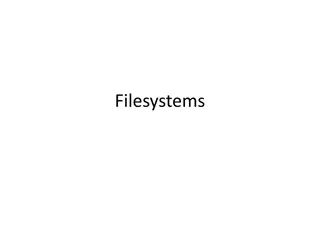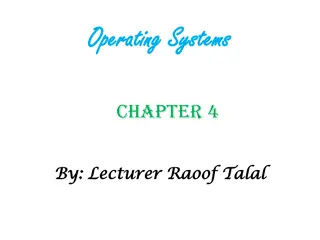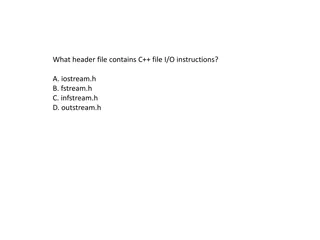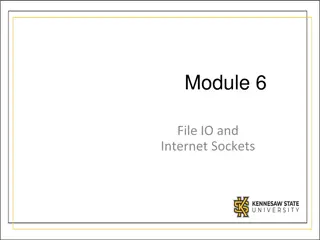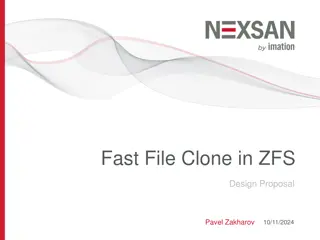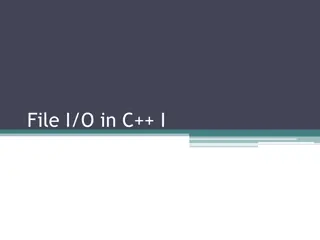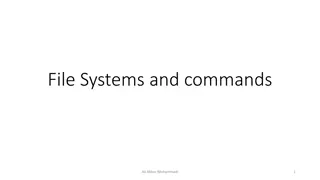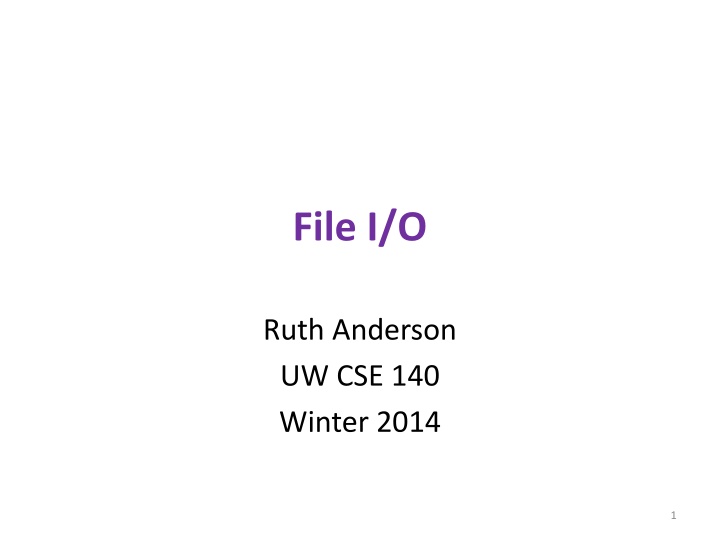
File Input and Output Operations in Programming
Learn about file input and output operations in programming, including when to use files, different types of filenames, and how to work with files in Python. Understand the importance of opening, reading, and writing data to files, as well as the concepts of absolute and relative filenames. Gain insights into managing the current working directory in Python and how to read files in Python effectively.
Download Presentation

Please find below an Image/Link to download the presentation.
The content on the website is provided AS IS for your information and personal use only. It may not be sold, licensed, or shared on other websites without obtaining consent from the author. If you encounter any issues during the download, it is possible that the publisher has removed the file from their server.
You are allowed to download the files provided on this website for personal or commercial use, subject to the condition that they are used lawfully. All files are the property of their respective owners.
The content on the website is provided AS IS for your information and personal use only. It may not be sold, licensed, or shared on other websites without obtaining consent from the author.
E N D
Presentation Transcript
File I/O Ruth Anderson UW CSE 140 Winter 2014 1
File Input and Output As a programmer, when would one use a file? As a programmer, what does one do with a file? 2
Files store information when a program is not running Important operations: open a file close a file read data write data 3
Files and filenames A file object represents data on your disk drive Can read from it and write to it A filename (usually a string) states where to find the data on your disk drive Can be used to find/create a file Examples: Linux/Mac:"/home/rea/class/140/lectures/file_io.pptx" Windows:"C:\Users\rea\My Documents\cute_dog.jpg" Linux/Mac: "homework3/images/Husky.png" "Husky.png" 4
Two types of filenames An Absolute filename gives a specific location on disk: "/home/rea/class/140/14wi/lectures/file_io.pptx" or "C:\Users\rea\My Documents\homework3\images\Husky.png" Starts with / (Unix) or C:\ (Windows) Warning: code will fail to find the file if you move/rename files or run your program on a different computer A Relative filename gives a location relative to the current working directory: "lectures/file_io.pptx" or " images\Husky.png" Warning: code will fail to find the file unless you run your program from a directory that contains the given contents A relative filename is usually a better choice 5
Examples Linux/Mac: These could all refer to the same file: "/home/rea/class/140/homework3/images/Husky.png" "homework3/images/Husky.png" "images/Husky.png" "Husky.png Windows: These could all refer to the same file: "C:\Users\rea\My Documents\class\140\homework3\images\Husky.png" "homework3\images\Husky.png" "images\Husky.png" "Husky.png" 6
Current Working Directory in Python The directory from which you ran Python To determine it from a Python program: >>> import os # "os" stands for "operating system" >>> os.getcwd() '/Users/johndoe/Documents' Can be the source of confusion: where are my files? 7
Reading a file in python # Open takes a filename and returns a file. # This fails if the file cannot be found & opened. myfile = open("datafile.dat") # Approach 1: for line_of_text in myfile: process line_of_text # Approach 2: all_data_as_a_big_string = myfile.read() myfile.close() # close the file when done reading Assumption: file is a sequence of lines Where does Python expect to find this file (note the relative pathname)? 8
Reading a file Example # Count the number of words in a text file in_file = "thesis.txt" myfile = open(in_file) num_words = 0 for line_of_text in myfile: word_list = line_of_text.split() num_words += len(word_list) myfile.close() print "Total words in file: ", num_words 9
Reading a file multiple times You can iterate over a list as many times as you like: mylist = [ 3, 1, 4, 1, 5, 9 ] for elt in mylist: process elt for elt in mylist: process elt How to read a file multiple times? Solution 1: Read into a list, then iterate over it myfile = open("datafile.dat") mylines = [] for line_of_text in myfile: mylines.append(line_of_text) use mylines Solution 2: Re-create the file object (slower, but a better choice if the file does not fit in memory) myfile = open("datafile.dat") for line_of_text in myfile: process line_of_text myfile = open("datafile.dat") for line_of_text in myfile: process line_of_text Iterating over a file uses it up: myfile = open("datafile.dat") for line_of_text in myfile: process line_of_text for line_of_text in myfile: process line_of_text This loop body will never be executed! 10
Writing to a file in python open for Writing (no argument, or "r", for Reading) # Replaces any existing file of this name myfile = open("output.dat", "w") # Just like printing output myfile.write("a bunch of data") myfile.write("a line of text\n") \n means end of line (Newline) Wrong; results in: TypeError: expected a character buffer object myfile.write(4) myfile.write(str(4)) Right. Argument must be a string myfile.close() close when done with all writing 11





